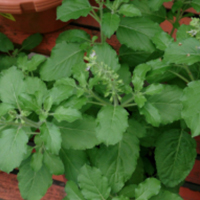Ocimum sanctum (holy basil), called Tulsi in India, is ubiquitous in Hindu tradition. Perhaps its role as a healing herb was instrumental in its sacred implication. Ayurvedic practice recommends Tulsi in several formulations to enhance immunity and metabolic functions as well as in the management of respiratory problems1.
A variety of biologically active compounds have been isolated from the leaves including ursolic acid, apigenin and luteolin. Pharmacological studies have validated the myriad healthful properties of Tulsi. Extracts from the plant have been found to reduce stress, modulate immunological functions and alleviate ulcers in experimental animals2. Ursolic acid was found to have anti-allergic properties. When administered to laboratory animals, the compound was found to inhibit mast cell degranulation and histamine release in the presence of allergen3. These studies reveal the potential role of Ocimum sanctum extracts in the management of immunological disorders including allergies and asthma. Recent studies have also revealed the chemopreventive effects of Tulsi extract in animal models. These effects are mediated through enhanced carcinogen-metabolizing enzyme activities and raised glutathione levels, facilitated by the active constituents in the extract, such as ursolic acid4. Researchers have also confirmed the efficacy of Ocimum sanctum extract in lowering elevated blood sugar levels5.
Phytochemistry
One of the major biologically active compounds in Ocimum sanctum is the triterpene compound ursolic acid. The structural resemblance of this compound to steroids is believed to be responsible for some of its pharmacological actions3. Ursolic acid is also one of the major constituents of a well known antioxidant herb, rosemary.
Ursolic Acid
The leaves of Ocimum sanctum yield an essential oil, which contains several biologically active compounds including eugenol, eugenal, carvacrol, mathychavicol, limatrol, and caryophylline. The essential oil has been known to demonstrate antimicrobial activity against Mycobacterium tuberculosis and Staphylococcus aureus in vitro. Furthermore, a study performed on mice and rats indicated that eugenol and methyleugenol possess adaptogenic (antistress) activity1.
The seeds and mucilage also contain oils with biologically important components. The seed oil contains fatty acids and sitosterol while the mucilage is made up of xylose and polysaccharides1. The fixed oil of Ocimum sanctum was found to possess anti-inflammatory activity in carrageenan and other mediator-induced paw edema in rats1a.
Clinical Studies
A controlled clinical study validated the role of Ocimum sanctum (Tulsi) as an adjunct in the management of a critical metabolic disorder in recent times – diabetes. A randomized, placebo-controlled cross-over single blind trial on 40 human volunteers suffering from Type II diabetes was performed. During the eight week trial, subjects received a daily dose of 2.5 g of Tulsi leaves powder or a placebo for four week periods. The results of the trial showed a 17.6 % reduction in fasting blood glucose and a 7.3% decline in postprandial blood glucose on treatment with Tulsi as compared to the blood glucose levels during treatment with placebo5 (Figure 1).

Figure 1: Effect of Ocimum sanctum treatment on blood sugar levels in patients with non-insulin dependent diabetes
Another study was conducted on rats and mice to observe the anti stress activity of Ocimum sanctum. To examine this anti stress activity, two groups of 20 mice each were used in a swimming endurance test. One group was treated with 100 mg/kg of Ocimum sanctum extract while the other group served as the control. The mice were allowed to swim in separate tanks. The endpoint was noted when each mouse drowned. The animals treated with Ocimum sanctum showed a significantly greater physical endurance than the control group (on an average, the treated animals swam for 1080 minutes as compared to the animals from the control group which swam for 385 minutes).
The effect of Ocimum sanctum extract was explored in another study against ulcers induced by cold stress, restraint ulcers, and aspirin administration in rats. Cold stress induced ulcers were produced by tying all four of the rat’s limbs and keeping them in a B.O.D. incubator for 2 hours. Restraint ulcers were created by tying the four legs in a back position. Aspirin-induced ulcers were produced by the injection of 200mg/(kg of body weight) of aspirin. In each case, one group served as a control and the other was given Ocimum sanctum extract (100 mg/kg i.p.). The stomach of each animal was examined for the presence of ulcers. After the experiment was complete, it was evident that restraint-stress and chemically induced gastric ulcers were absent in Ocimum sanctum. The results of these studies indicate that the administration of Ocimum sanctum produces a nonspecific increased resistance against a variety of stress-induced pathological changes in animals2.
The effects of Ocimum sanctum on immunological functions has also been studied. In a study performed on rats immunized by sheep red blood cells (SRBC), it became apparent that pretreatment of Ocimum sanctum enhanced the production of antibodies, including IgE antibody and anti-SRBC. In addition, the in vitro effect of Ocimum sanctum on antigen-induced histamine release was studied by sensitizing rats to antigen. Ocimum sanctum significantly inhibited antigen induced histamine release from mast cells. Based on these results, the authors concluded on the beneficial effects of Ocimum sanctum on the immune mechanism at various levels, such as on antibody production6.
Experiments also show that Ocimum sanctum possess protective properties against gamma radiation. The water and aqueous ethanol extracts of Ocimum sanctum were given in single doses and multiple doses before a whole body exposure to gamma radiation in mice. It was found that the water extract of the plant was more effective and less toxic than the ethanol extract. Also, an optimum dose of 50 mg/(kg of body weight) of the water extract, at 10 mg/kg of body weight/day for five consecutive days gave the best protection against the effects of radiation7.
In summary, Ocimum sanctum is a safe adjunct to conventional therapy in the management of diabetes and immunological as well as stress-related conditions. Its record of use in Ayurvedic tradition spans several centuries. Studies performed on animal models to date using levels as high as 100 mg/kg of the extract administered intra-peritoneally, did not reveal untoward side effects2. Human diabetic subjects receiving 2.5 g of Ocimum sanctum leaves powder for four weeks also reported no unfavorable side effects5.
References
- Selected Medicinal Plants of India: Chemexcil, 1992, 225-227.
- Bhargava, K.P. and Singh, H. “Anti-stress Activity of Ocimum sanctum Linn”. Indian Journal of Medical Research: March, 1981, (73) 443-451.
- Rajasekaren, M., et. al. “Mast Cell Protective Activity of Ursolic Acid-A Triterpene from the Leaves of Ociumum Sanctum L. Journal of Drug Development: 1989, 2(3), 179-182.
- Banerjee, S., et. al. “Modulatory Influence of Alcoholic Extract of Ocimum Leaves on Carcinogen-Metabolizing Enzyme Activities and Reduced Glutathione Levels in Mouse”. Nutrition and Cancer: 1996, 25(2), 205-217.
- Agrawal, P., et. al. “Randomized Placebo-Controlled, Single Blind Trial of Holy Basil Leaves in Patients with Noninsulin-Dependent Diabetes Mellitus. International Journal of Clinical Pharmacology & Therapeutics: Sept. 1996, 34 (9), 406-409.
- Bhattacharya, S.K., et. al. “Effect of Ocimum Sanctum Linn. on Humoral Immune Responses”. Indian Journal of Medical Research: April, 1988, (87), 384-386.
- Devi, P. Uma and Ganasoundari, A. “Radioprotective Effect of Leaf Extract on Indian Medicinal Plant Ocimum Sanctum”. Indian Journal of Experimental Biology: March, 1995, (33) 205-208.


